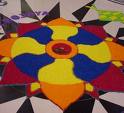PONGAL O PONGAL
Imagine four days of Thanksgiving! Turkey, turkey and more turkey? Not if you live in Tamilnadu. This South Indian state celebrates the end of the harvest season quite differently.
Firstly, its called ‘Pongal’ and not ‘Thanksgiving’ and it’s celebrated for four days. What are they celebrating? A good harvest of course. In South India the major food crops are rice and sugarcane, which are harvested in early January. So Pongal is usually celebrated in the third week of January.
BHOGI
On the first day or Bhogi, people light bonfires outside their homes and burn all old clothes and other stuff they don’t need. The whole house is spruced up for the Pongal festivities. Boys and girls have a fun time tossing things into the bonfire and watching them eaten up by the flames.
SURYA PONGAL
The next day is Surya Pongal. Everybody rises early and has a bath. The lady of the house draws kolams - elaborate designs out of rice flour (think sidewalk chalk) on the front porch. Mango leaves on a string are hung to the top of the front door. Whole sugarcanes are used to decorate the front porch. People make a sweet dish, also called pongal, out of milk, freshly harvested rice and jaggery(brown sugar). They offer pongal and sugarcanes to Surya or the Sun God and pray to him. In villages, pongal is made on firewood stoves outside the house. It is cooked in freshly baked earthen pots decorated with pretty designs. The rice and milk are allowed to boil over and overflow from the pots. When this happens, people happily shout ‘pongal o pongal’. Pongal in Tamil means overflow. It is a joyous day and people meet friends and relatives and share sweets with them.
MAATU PONGAL
The third day is important to all dairy farmers as well, and is aptly named Maatu Pongal. Maadu is the Tamil word for cow. Cows and bulls are scrubbed clean. Their horns are painted and decorated with bells. People hang garlands,bells and beads around the necks of the cattle. The animals are fed tasty treats and taken around the village. It’s the farmer’s way of thanking the bulls that pull the plough and the cows that give milk in abundance. In some rural areas, men play a game called Jalli kattu. A bunch of rupees (Indian currency) is tied to a bull’s horn and the bull is allowed to run wild. Men chase the bull and try to get the money.
KAANU PONGAL
On the fourth and final day, people go out, meet friends and have picnics. It’s called Kaanu Pongal (Kaanu- see). On this day girls pray for their brothers. They prepare a variety of rice dishes (lemon rice, tamarind rice, coconut rice etc.) and make little balls out of it. These rice balls are kept on a plantain leaf outside the house and crows eat them up. Each girl gets her own plantain leaf to fill with rice balls. Boys in turn give gifts and money to their sisters.
Other states in South India (Karnataka, Andhra Pradesh) celebrate Pongal with some variations. In other parts of India, it is known by different names like Makara Shankaranthi or Lohri. Miles away in America, the pilgrims celebrated their first harvest after setting foot in the New World. Today, Thanksgiving brings families together for a turkey feast.Whether it’s four days of pongal or one day of turkey, thanksgiving is a part of almost all world cultures!
